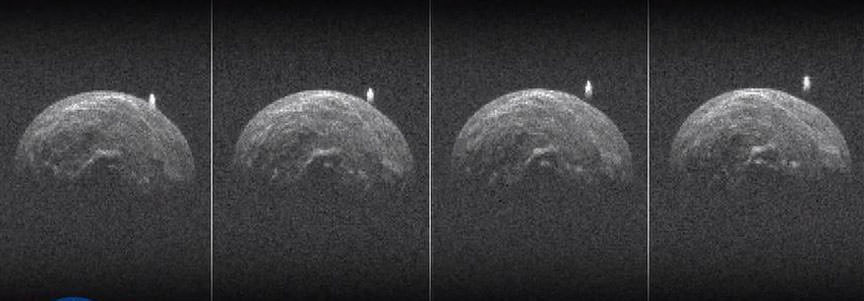New video of 2004 BL86 and its moon
Newly processed images of asteroid 2004 BL86 made during its brush with Earth Monday night reveal fresh details of its lumpy surface and orbiting moon. We’ve learned from both optical and radar data that Alpha, the main body, spins once every 2.6 hours. Beta (the moon) spins more slowly.
The images were made by bouncing radio waves off the surface of the bodies using NASA’s 230-foot-wide (70-meter) Deep Space Network antenna at Goldstone, Calif. Radar “pinging” reveals information about the shape, velocity, rotation rate and surface features of close-approaching asteroids. But the resulting images can be confusing to interpret. Why? Because they’re not really photos as we know it.
For one, the moon appears to be revolving perpendicular to the main body which would be very unusual. Most moons orbit their primary approximately in the plane of its equator like Earth’s moon and Jupiter’s four Galilean moons. That’s almost certainly the case with Beta. Radar imagery is assembled from echoes or radio signals returned from the asteroid after bouncing off its surface. Unlike an optical image, we see the asteroid by reflected pulses of radio energy beamed from the antenna. To interpret them, we’ll need to put on our radar glasses.
Bright areas don’t necessarily appear bright to the eye because radar sees the world differently. Metallic asteroids appear much brighter than stony types; rougher surfaces also look brighter than smooth ones. In a sense these aren’t pictures at all but graphs of the radar pulse’s time delay, Doppler shift and intensity that have been converted into an image.

In the images above, the left to right direction or x-axis in the photo plots the toward and away motion or Doppler shift of the asteroid. You’ll recall that light from an object approaching Earth gets bunched up into shorter wavelengths or blue-shifted compared to red-shifted light given off by an object moving away from Earth. A more rapidly rotating object will appear larger than one spinning slowly. The moon appears elongated probably because it’s rotating more slowly than the Alpha primary.
Meanwhile, the up and down direction or y-axis in the images shows the time delay in the reflected radar pulse on its return trip to the transmitter. Movement up and down indicates a change in 2004 BL86’s distance from the transmitter, and movement left to right indicates rotation. Brightness variations depend on the strength of the returned signal with more radar-reflective areas appearing brighter. The moon appears quite bright because – assuming it’s rotating more slowly – the total signal strength is concentrated in one small area compared to being spread out by the faster-spinning main body.
If that’s not enough to wrap your brain around, consider that any particular point in the image maps to multiple points on the real asteroid. That means no matter how oddly shaped 2004 BL86 is in real life, it appears round or oval in radar images. Only multiple observations over time can help us learn the true shape of the asteroid.
You’ll often notice that radar images of asteroids appear to be lighted from directly above or below. The brighter edge indicates the radar pulse is returning from the leading edge of the object, the region closest to the dish. The further down you go in the image, the farther away that part of the asteroid is from the radar and the darker it appears.
Imagine for a moment an asteroid that’s either not rotating or rotating with one of its poles pointed exactly toward Earth. In radar images it would appear as a vertical line!
If you’re curious to learn more about the nature of radar images, here are two great resources:
* How Radio Telescopes Get “Images” of Asteroids by Emily Lakdawalla
* Goldstone Solar System Radar Observatory: Earth-Based Planetary Mission Support and Unique Science Results


For me it’s always fun trying (and failing a bit…) to wrap one’s mind around how to read these radar “images”. Many thanks for the explanation!
Hey Tony, thanks! I’ve always wanted to write about the topic.
I really like the way Bob explains complicated subjects with Shakespearian ease I now have a much better understanding of how we get images from Radio Telescopes thank you Bob and I cant wait for your next Great Topic…..
UFOsM,
That’s nice of you to say. Thank you!
Very useful write-up, and thanks for the links.